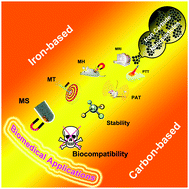Iron carbide nanoparticles: an innovative nanoplatform for biomedical applications
Abstract
Iron carbide nanoparticles (ICNPs) are nano-intermetallic compounds that consist of iron and carbon. Benefiting from the magnetic and chemical activity of iron, and/or mechanical strength and chemical inertness of carbon, they have been widely applied in energetic and biomedical-related fields. Particularly in biomedicine, ICNPs have shown high colloidal stability and good performance in magnetic-dependent diagnosis and therapies such as magnetic resonance imaging (MRI) and magnetic hyperthermia (MH), due to their high magnetization and moderate coercivity. The carbon content protects ICNPs from oxidation and corrosion (ion release), which prolongs their life time and reduces their toxicity in physiological environments, and endows nanoparticles (NPs) with high performance in carbon-relevant theranostics as well. On this basis, ICNPs have great promise in multi-modal imaging or imaging-guided tumor-selective therapy to realize precise diagnoses with mild side effects. This paper aims to cover the state of the art applications of ICNPs in biomedicine, primarily including MRI, MH, magnetic targeting (MT), magnetic separation (MS), photothermal therapy (PTT) and photoacoustic tomography (PAT). The biocompatibility of ICNPs is also addressed.

- This article is part of the themed collection: Recent Review Articles


 Please wait while we load your content...
Please wait while we load your content...